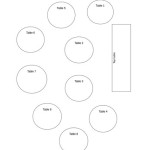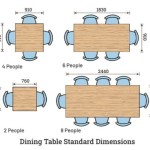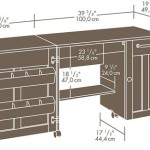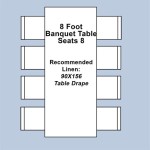Understanding Standard Table Height in Millimeters
Table height, a seemingly simple measurement, plays a crucial role in ergonomics, comfort, and functionality. The standard table height, typically expressed in millimeters (mm) for precision in many applications and regions adhering to the metric system, aims to accommodate a wide range of users and tasks. Deviations from this standard can lead to discomfort, poor posture, and reduced productivity, particularly in work environments. This article delves into the complexities of standard table heights, exploring different types of tables, the factors influencing optimal height, and the implications for both individual users and organizational settings.
The concept of a "standard" table height is, in reality, an approximation. Human beings possess a diverse range of physical attributes, and what constitutes a comfortable and ergonomic height for one person may be unsuitable for another. Therefore, the established standard represents a compromise designed to serve the majority of users. Understanding the factors that contribute to ergonomic table design and the adjustments that can be made to accommodate individual needs is crucial for creating a functional and healthy environment.
Key Point 1: The Generally Accepted Standard Table Height
The generally accepted standard height for a dining table or a desk is between 710 mm and 760 mm (approximately 28 to 30 inches). This range is designed to accommodate the average adult when seated in a standard chair. This height allows for comfortable legroom beneath the table while providing a surface that is within easy reach for tasks such as eating, writing, or using a computer. This range is not arbitrary; it's been developed through ergonomic studies and practical experience to minimize strain and maximize usability.
This range considers the average seated height of an adult, which is typically between 400 mm and 480 mm. The difference between the seated height and the table height allows for sufficient legroom and space for the thighs to comfortably clear the underside of the table. However, it's important to note that this is an average, and adjustments may be necessary for individuals who are significantly taller or shorter than average.
Furthermore, the type of chair being used in conjunction with the table also plays a critical role. A chair that is too high or too low relative to the table can negate the benefits of a standard table height. The ideal scenario is one where the user can sit with their feet flat on the floor, their knees at a 90-degree angle, and their elbows resting comfortably on the tabletop without hunching or straining. This neutral posture reduces the risk of musculoskeletal disorders and promotes long-term comfort.
The standard table height range is particularly relevant for furniture manufacturers, interior designers, and architects who are responsible for creating functional and comfortable spaces. By adhering to these guidelines, they can ensure that their designs are accessible and accommodating to a wide range of users. However, it's also important to recognize the limitations of a one-size-fits-all approach and to consider the potential need for adjustable or customized solutions.
Commercial spaces, such as offices and restaurants, often rely on standard table heights to optimize space utilization and cater to a diverse clientele. While individual preferences may vary, the standard range provides a solid foundation for creating a functional and aesthetically pleasing environment. The consistency in table height also contributes to a sense of uniformity and professionalism, which can be particularly important in formal settings.
Key Point 2: Variations in Table Height for Different Purposes
While the 710 mm to 760 mm range serves as a general standard, different types of tables are designed with specific purposes in mind, leading to variations in height. Coffee tables, for example, are significantly lower than dining tables, typically ranging from 400 mm to 500 mm. This lower height is intended to complement the lower seating positions of sofas and armchairs in living rooms.
Bar tables, on the other hand, are considerably higher than standard tables, often reaching heights of 1000 mm to 1100 mm. This elevated height is designed to be used in conjunction with bar stools, providing a comfortable surface for standing or sitting while enjoying drinks or casual meals. The increased height also facilitates social interaction and allows for better visibility in crowded environments.
Drafting tables, commonly used by architects and artists, are often adjustable and can range from standard table height to standing desk height. This adjustability allows users to work in a variety of positions, reducing strain and promoting creativity. The ability to tilt the tabletop is another common feature of drafting tables, which further enhances ergonomics and allows for more comfortable drawing and sketching.
Console tables, typically placed against walls in hallways or living rooms, often fall within the range of 750 mm to 900 mm. This height allows them to serve as a convenient surface for displaying decorative items or holding everyday essentials. The specific height of a console table may vary depending on its design and intended use.
Understanding the specific purpose of a table is crucial for selecting the appropriate height. Choosing a table that is too high or too low can lead to discomfort and reduced functionality. Factors such as the intended use, the type of seating being used in conjunction with the table, and the overall aesthetic of the space should all be considered when determining the optimal height.
In addition to the table type, the age and physical characteristics of the user should also be taken into account. Children, for example, require lower tables than adults. Adjustable tables can be an excellent solution for households with children or for individuals who have varying needs.
Key Point 3: Adjustability and Ergonomics: Adapting to Individual Needs
Recognizing that a fixed standard table height cannot accommodate everyone, the concept of adjustability has gained significant traction in recent years, particularly in office environments. Adjustable height desks, often referred to as sit-stand desks, allow users to alternate between sitting and standing throughout the day, promoting better posture, reducing back pain, and improving overall health.
These desks typically have a height range that extends from approximately 650 mm to 1300 mm, allowing users to find the optimal height for their individual needs. The adjustability can be manual, using cranks or levers, or electric, using push-button controls. Electric adjustable desks offer greater convenience and precision, allowing users to easily switch between sitting and standing positions.
The benefits of adjustable height desks extend beyond mere comfort. Studies have shown that alternating between sitting and standing can improve circulation, reduce fatigue, and increase productivity. By allowing users to adopt a more dynamic posture, these desks can help prevent the negative health consequences associated with prolonged sitting.
In addition to adjustable height desks, other ergonomic accessories can further enhance the comfort and functionality of a workspace. Monitor arms, for example, allow users to adjust the height and position of their screens, reducing neck strain. Ergonomic keyboards and mice can also help prevent repetitive strain injuries.
The implementation of ergonomic principles in table design is not limited to office environments. Adjustable height tables are also becoming increasingly popular in homes, particularly for individuals who work remotely or spend a significant amount of time using computers. The ability to customize the table height allows users to create a more comfortable and productive workspace, regardless of their physical characteristics or the tasks they are performing.
The future of table design is likely to be characterized by an increasing emphasis on adjustability and ergonomics. As awareness of the health risks associated with prolonged sitting grows, the demand for adjustable height desks and other ergonomic solutions will continue to increase. Manufacturers will likely respond by developing more innovative and user-friendly products that cater to the diverse needs of individuals and organizations.
The selection of an appropriate table height, whether standard or adjustable, is a critical aspect of creating a functional and comfortable environment. By understanding the factors that influence optimal height and considering the specific needs of the user, it is possible to create spaces that promote health, productivity, and well-being. The millimeters truly do matter when it comes to long-term comfort and ergonomic health.

What Is The Ideal Dining Table And Chair Height

What Is The Ideal Dining Table And Chair Height

Dining Room Table Height What Is Standard Medium Size Of Dimensions Kitchen Chairs

Bespoke Dining Tables And The Height We Make Them Orpago

Redress

What Is The Ideal Dining Table And Chair Height

Pairing Stool Heights With Bench Nomi

Dining Table Size Buildsearch

Standard Polished White Stainless Steel Study Table

Result For Standard Bar Counter Spacing Measurements Mm Kitchen Island Height








